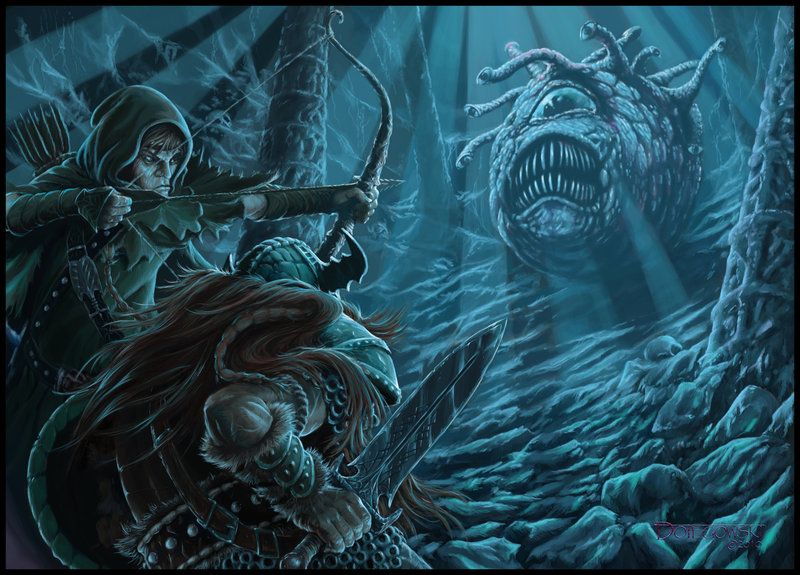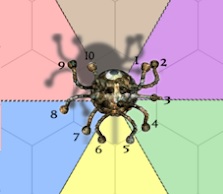Beholder
| Species | beast |
| No. Appearing | 1 |
| Behaviour | malevolent |
| Range | subterranean |
| Size | 4 to 6 ft. in diameter |
| Weight | 550 lbs. |
| Intelligence | 15 |
| Armour Class | 0 |
| Hit Dice | 15 |
| Action Points | 1 |
| Max. Stride | {{{stride}}} |
| THAC0 | 12 |
| Hp/Die | d10 |
| Attack Forms | 1: maw (attack) |
| Damage | maw [3–24] |
| Special Attacks | anti-magic, cause wound, death, disintegrate, fear, hold person or monster, hypnotism, levitation, petrification, sleep, slow, telekinesis |
The beholder, or eye-tyrant, is well-known as one of the deadliest creatures to exist anywhere. It's only been encountered at the core of deep dungeons, preferring to make its lair in a small cave. The size is chosen to ensure the beholder room enough to unleash its infamous arsenal of magical attacks, while the line-of-sight keeps interlopers in range of the beast's powers.
Lair
Typically, the beholder is supported by upper levels of lesser creatures, helplessly in the beholder's thrall. While allowed to dwell and live out their lives, these slave creatures are organized so as to protect the beholder's lair and give warning to the beast if anyone should attempt to fight their way down through the complex warrens above. These slaves also feed the beholder, sometimes with their own bodies. A beholder's appetite is prodigious.
In reality, the beholder is notably vulnerable. Despite its powers, if enough creatures were to give their lives in a rush against it's attacks, the beholder could be overwhelmed. Though many would die, the remainder — with oil and torches — could set the beholder's lair alight. Another means might to be seal the beholder in its own lair, or somehow bring about an avalanche. Even if it survived, the beholder would be forced to look for its own food. This might enable a group of adventurers, or even a large beast to take it by surprise and bring about it's end.
The beholder's greatest power is its intelligence: knowing precisely how to make its lair safe and cultivate its minions, so that they're either too frightened or too dependent to turn on their master.
Description
The beholder is shaped like a globe, covered in heavy plating and hardened ridges, causing its surface to appear stone-like. The beholder has eleven eyes altogether. It has a large mouth and one great eye that identifies the front of the sphere. Atop the sphere are ten stalks, each of which is topped with a much smaller eye.
Each of these eyes are blessed with a unique and individual power, any of which may be employed by the beholder once per round (see below). These eyes are grouped on the beholder's head in a particular fashion; none of these eyes has the power to affect a 360° circle around the beholder. This means, depending on how the beholder chooses to orient itself, or upon which side it is approached, some of the eyes can be brought to bear on the target and some not.
Advantages
A beholder is able to accomplish a whirlwind of attacks with its eleven eyes — a great eye upon the main orb of its body and ten additional eyes attached by stalks to the top of the creature's head. The beholder's great eye is its main oracle, denoting the front of the beast; it bulges outwards from the body and is able to see in a 180° arc. This eye possesses an anti-magic ray (see below).
On the image shown, this enables the beholder to attack opponents in the orange, brown and purple areas, including creatures standing on the boundaries of those zones.
| Stalk # |
Arc of Fire | Effect |
|---|---|---|
| 1 | brown, purple | disintegrate |
| 2 | brown, purple | telekinesis |
| 3 | purple, green | sleep |
| 4 | green, yellow | hypnotism |
| 5 | green, yellow | fear |
| 6 | yellow, blue | slow |
| 7 | yellow, blue | hold person or monster |
| 8 | blue, orange | flesh-to-stone |
| 9 | orange, brown | cause wound |
| 10 | orange, brown | death |
The stalks upon the beholder's head are only partially flexible, so each can only attack a 120° arc and no better. The table indicates which stalks can attack which coloured areas surrounding the beholder.
Eye Powers
The description of these special powers is outlined as follows, numbers corresponding to the eye that can use that power. Each eye can be used once per round.
- Disintegrate. Causes complete annihilation of the body of one creature, leaving nothing behind that can be raised or otherwise preserved. The creature is entitled to a saving throw against magic. The beholder can affect one creature in this way per round. Creatures that are disintegrated can be retrieved only through a wish spell.
- Telekinesis. Enables the beholder to move or hold immobile any object or creature up to 375 lbs. weight. The beholder is most likely to use the power to seize an attacker and hurl that individual against a distant wall or towards the ceiling (depending on the ceiling's height) to cause, effectively, falling damage. The ceiling is preferred, as this falling damage can be accumulated twice, once upon hitting the ceiling, then again when the creature falls back to the floor. The beholder may only affect one creature per round in this fashion, and may commit only one action against that creature. If the creature is viewed as especially dangerous, the beholder can hold them immobile indefinitely. If it is determined that a missile weapon has hit the beholder during the player's turn, the beholder may grab that missile and eliminate that hit, as though it never occurred — however, the beholder must then forego using its telekinesis eye during the beholder's next move. Only one missile may be stopped in this manner per round.
- Sleep. Affects creatures like the 1st level magic spell, sleep. Causes sleep in one creature, no saving throw. The creature falls asleep and can be roused. However, if the creature is not interacted with by someone, the sounds of battle will not awaken the creature, so that the effects of the sleep will last from 5–30 rounds.
- Hypnotism. Affects a single creature like the 1st level illusionist spell, hypnotism, with the exception that the beholder's power does not prevent the hypnotized creature from harming his or her allies. Allows a save against magic. The effect lasts only 2–5 rounds.
- Fear. Affects a single creature like the 3rd level illusionist spell, fear. Allows a save against magic. The effect lasts for 16 rounds.
- Slow. Affects a single creature like the 3rd level mage spell, slow, causing all action point (AP) costs to be doubled, precluding the creature from running. The creature is limited to performing its normal number of attacks every two rounds, so that a creature normally able to attack once per round would now do so every other round, while a creature normally able to attack twice a round would now attack once each round. There is no saving throw. The effect lasts for 6 rounds.
- Hold Person or Monster. Affects a single creature like the 2nd level cleric spell, hold person. Allows a save against magic. The effect lasts for 4 rounds.
- Flesh-to-Stone. The reverse of the 6th level mage spell, stone-to-flesh. The effect will transform the creature into solid stone, including all that the creature is carrying or wearing, including another person. Allows a save against magic. The effect is permanent.
- Cause Wound. Causes 22 points of damage, half if a save against breath weapon is made. If the total damage is 22, the victim will continue to bleed for 2 hit points per round thereafter, 1 point per round if the save was successful, until the wound is bound or otherwise treated.
- Death. Causes the death of one creature, no saving throw. The creature can be raised or resurrected, but cannot be brought back to life using death's door.
- Anti-Magic Ray. Produced by the great eye, will drain the magical ability and effect from one creature. If the spellcaster is actively casting a spell, the casting is disrupted and the spell is lost for that day. Ongoing spells that have already been cast, regardless of whether the spell requires the concentration of the caster, will also be dispelled. Moreover, once a character is hit with the anti-magic ray, that character will be unable to cast a spell or cantrip, make use of a magic item, or employ magic resulting from a sage ability, for 3 rounds.
Engaging a Beholder in Combat
Obviously, because of the Beholder's formidable power, defenders will be anxious to find strategies to counteract the many eye attacks or at least fool the Beholder into wasting its powers on lesser combatants. As well, knowing which attacks can affect which arcs around the beholder can be useful, if protection spells of various sorts can be obtained.
Most will be anxious to destroy eyes, in order to reduce the beholder's potential for destruction, if only to weaken the creature before a retreat is called, so that another engagement can be arranged by the survivors. It is possible to destroy all of the beholder's eyes except for the great eye, which will survive so long as the beholder's body remains intact. To destroy the great eye, the beholder must be reduced in hit points to -10 (it counts as a leveled creature). To destroy an eyestalk, however, is easier. It can be struck with a weapon, swung, thrown or fired, so long as AC -5 is successfully hit. The beholder will usually levitate high enough above the floor to preclude direct melee and may save its telekinesis power for the initial salvo, that will tend to take place as a party rushes in. Of course, a beholder may be surprised by someone that is invisible, under the effect of a sanctuary spell or using various magic items for the purpose of deception, enabling a lucky shot that could take out the death or disintegration eyes (or whichever seems best).
However, it should not be supposed that the beholder will be alone, or that its lair will have a conveniently flat floor or that there won't be traps set by its minions designed to reveal hidden interlopers. The beholder is of genius intelligence and will be prepared for most simple tactics; would-be attackers should be warned.
As well, it should be understood that there are two species of beholder. The above describes the "left-handed" beholder. In the "right-handed" beholder, the eyes are located in a mirrored position to that which appears in the diagram (left is right and right is left). It requires a true expert of beholders to visually tell the difference.
See Bestiary

